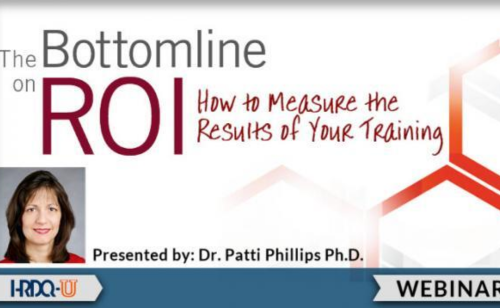We hosted a free webinar, “The Bottomline on ROI: How to Measure the Results of Your Training,” with over 500 registrants presented by Dr. Patti Phillips. She is a recognized expert in measurement and evaluation. The recorded webinar sparked engaging discussions on return on investment (ROI). The goal of the presentation was to give the audience an overview of the ROI methodology. It’s the most documented approach to measuring to evaluating all types of human resources programs. That includes learning and development, any kind of performance improvement initiative, leadership development, and coaching.
This blog will highlight key takeaways from the webinar, capturing the participants’ positive feedback, sharing valuable insights on ROI in the business world, and the five different levels of evaluation when it comes to an ROI.
The Bottomline on ROI: How to Measure the Results of Your Training
What the participants had to say about the webinar
- “I learned a lot of valuable information. Thank you.”
- “Thank you, Patti. I wish I had more time to pick your brain!”
- “Thank you for providing this wonderful learning event.”
The importance of credible data in ROI tracking
According to Patti, “When we’re measuring and evaluating any type of program and project, the key is to be able to answer the questions: What are you doing? How are you doing it? And why are you doing it? So ensuring you have a method, a process, and a set of standards allows us to answer those questions in such a way that stakeholders get it. They understand what we’re doing and what the results mean. That means we have to have those conservative standards. We have to have consistency. We want reliability, and we need to get credible sources and data, and in the end, the output of an evaluation needs to create a call for action. Your ROI or measurement evaluation project is not in the numbers produced from the process but in the actions taken. So this new definition of value is really driving our approaches these days in the area of measurement, evaluation, and analytics.”
Is a negative ROI okay?
When asked if there was anything positive about a negative ROI, the group had to stop and think. “The answer is yes. A negative ROI can be a positive thing because it means you have an opportunity to improve. “So the value of a negative is in that opportunity for improvement. What we don’t want you to do is be afraid of them because if you do have a negative ROI and your senior executive has asked you to demonstrate an ROI for a program, they probably already know it’s negative. Something tells them they need to see what’s happening with that program. So what you want to do is find the negative first. The idea is to look for what’s working but look for what’s not working so you can improve it, and sometimes that improvement is kill the program.”
Five Levels of Evaluation in ROI
There are five different levels of evaluation when it comes to an ROI. Dr. Phillips goes more in-depth in the webinar.
Here are the five levels of evaluation in ROI:
- Level 1 is Inputs and Indicators
- Level 2 is Reaction and Perceived Value
- Level 3 is Learning and Confidence
- “It doesn’t matter what people know. It’s what people do with what they know that matters. There’s that adage out there that knowledge is power. Knowledge isn’t powerful. It’s what people do with the knowledge that makes it powerful.”
- Level 4 is Impact and Consequences
- Level 5 is ROI
“Anytime we have ROI tracking, we report those intangibles, and we always tell the story. We communicate results to stakeholders. We will work in organizations that have done a phenomenal job collecting, and analyzing data, but they’re not telling anyone. Folks, evaluation without communication is a worthless endeavor. Bottom line… you’re wasting time, money, and effort. So you’ve got to communicate results and do something with the data. In the end, we have that complete story of program success. Here’s what we invested. Here’s what people thought about it. Here’s what they learned and what they did with what they learned. As a result, we’ve improved output, quality, cost, time, customer satisfaction, job satisfaction, work habits, and innovation. We know that improvement is due to our program because we isolate the effects of the program. When we convert benefits to money and compare it to the cost, we calculate this ROI, and by the way, we look at all the intangibles. The complete story of success.”
Are you interested in learning the method for measuring ROI accurately?
Watch this webinar to gain further insights on ROI benefits and tracking.
Dr. Patti Phillips is a recognized expert in measurement and evaluation and president & CEO of the ROI Institute ⇗. She serves as faculty for the UN System Staff College, a Professor of Practice for The University of Southern Mississippi’s Ph.D. in Human Capital Development program, and a Principal Research Fellow at The Conference Board. Patti is an award-winning author and editor of numerous books and articles, including The Bottomline on ROI ⇗, Ten-Steps to Successful Business Alignment ⇗, Measuring ROI in Learning and Development: Global Case Studies ⇗, and Measuring the Success of Coaching. Dr. Phillips’ clients include Fortune 500 companies, federal and state government agencies, and non-governmental organizations.
*Please note: this post may contain affiliate links. If you click one of them, we may receive a commission at no extra cost to you.
Discover more HRDQ-U coaching skills blogs and webinars
Access more valuable HRDQ-U content by Dr. Patti Phillips
Explore HRDQ Store’s ROI training resources ⇗
How did you like this blog on ROI tracking? Comment below!
















